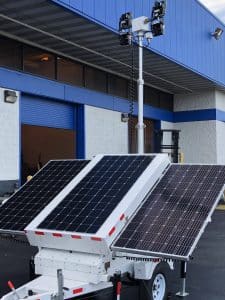Increasing Airport Security with Solar LightsPosted by in Most Popular.
A few years ago, a Colorado news outlet reported that several cars were vandalized inside of a parking lot at Denver International Airport. Two of the vandalized cars were actually stolen. What people initially thought was a safe area to store vehicles (they were rentals owned by a family) turned out to be unsafe for various reasons. Whatever the reason behind the unfortunate chain of events, sometimes crime can't be avoided--it's Murphy's Law. However, that doesn't mean crime can't be minimized through proper safety methods and the right kind of lighting equipment. Along with regular patrol and surveillance, proper lighting in a parking lot is a necessity for deterring theft and vandalism. However, it's not just any kind of lighting that suffices for crime and theft deterrence. Solar lights for airports that use LED fixtures are fantastic for keeping commuters and their belongings safe. Here's some reasons why these particular lights are superior for parking lots and comparisons between competing light technologies. Comparing Other Lights--HPS and Metal HalideColor ReproductionLED lights are known for proper color reproduction because they have a high Color Rendering Index (CRI) in comparison with other technologies. High-Pressure Sodium lamps typically fall under a CRI of 25, which is a very poor rating (LEDs are 80 on average). Because of their typical yellowish light, identifying color under these kinds of lights is difficult at best. Reds often tend to show up darker than usual (almost black). In the event of a crime, witnesses may not be able to properly identify an individual or what they're wearing under light fixtures with poor CRI ratings. Plus, there are financial incentives to installing high-CRI lights (check out California's Title 24 for more information). High-pressure sodium lights aren't up to snuff when compared to LED lighting technology and how they perform for security reasons. Metal halide lamps have some of the highest CRI ratings on the market, but at a significant disadvantage: the lamps typically take time to warm up in order to display their highest brightness (around 15 minutes), and their end-of-life behavior includes exploding--we're sure nobody desires a lamp exploring above their head when they're walking to their car at night. Plus, a metal halide lamp total operating time is around 15,000 hours--compare that to 100,000 hours of runtime for LED lights, and there's a clear winner of technology. Metal halide isn't prime for increasing safety in airport parking lots, and the level of maintenance is far too high and constant to maintain high levels of security. Imagine replacing metal halide bulbs for every airport security light in a parking lot every 18 months--not very practical. Energy & EfficiencyMetal halide lights have a system efficiency of less than 30 lumens per watt because they're omnidirectional, so light often times needs to be bounced towards the "focus" areas. Similarly, HPS lights are omnidirectional as well, wasting light because not all of it is targeted on the specific subject in question (in this case, parking lots). In comparison, LED fixtures are not omnidirectional, so their efficiency rating is better suited for airport perimeter lighting since the light is more focused. An LED light fixture focuses light in a 180-degree range, wasting less light and using less energy for superior brightness. The Significance of Airport Solar LightsAnother reason why solar lights are a much stronger option for airport perimeter lighting is because each light is standalone and doesn't require connectivity to a main power grid. We recently had a full project where we replaced an archaic lighting system at Santa Monica Airport with airport security lights. Because none of the lights needed power grid connectivity, we were able to install them on the original light pedestals, saving the customer several thousands of dollars and weeks of time since they didn't need to dig into the concrete for wiring the new lights. It's examples like these that demonstrate why solar lights for airports are a superior choice over traditional. Plus, in any event that the main power grid fails, the lights will remain on. That's just another feature to enhance safety for commuters--ensuring that, if all else fails, people won't be left in darkness in the middle of an airport parking lot. Without proper lighting, the probability of personal injury and/or car accidents rises--avoid liability by ensuring people have the best airport security lights. The Kind of Standards with LED Lights You NeedIn order to maximize the light coverage per solar light pole, the best kind of light fixtures have strong light distribution patterns, or the projected pattern of light a fixture will disperse onto a surface. It's important to note, however, that the best lighting practice for an area with security in mind is outlined in a guide published by the Illuminating Engineering Society of North America (IES) called the IES G-1-16. We won't bore you with the details of what's in the guide, but just rest assured that we follow the standards outlined in the IES manual--so our lights are not only just highly advanced airport security lights, but they're configured specifically with security in mind. The light fixtures used for proper airport security are Type III fixtures so the light "throw" is a little larger and the lights can line the perimeter of the lot. We accept no less than the standard for security lighting. In conclusion, the solar lights for airports that we manufacture are the best available on the market--with a high color reproduction index, low maintenance, long-lasting light fixtures, bill-less upkeep, self-sufficiency, and low installation costs (avoiding trenching and wiring), rest assured that your lighting setup from Greenshine New Energy will bring the best in security for your airport. Contact us to learn about how you can increase safety and save money on your next lighting project. It really is a "bright" idea.
Most Popular
|
ArchivesNo Archives Categories
Want More Info? |
LATEST NEWS & ARTICLES

